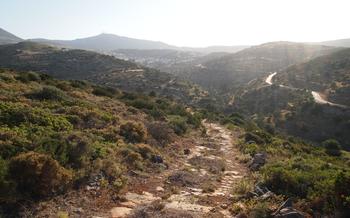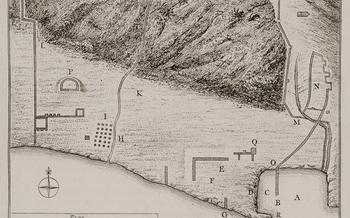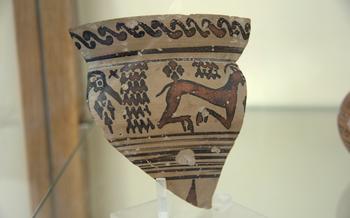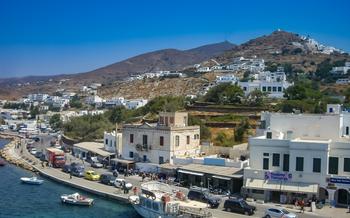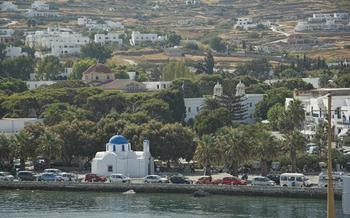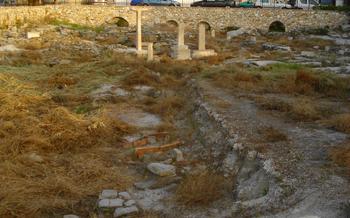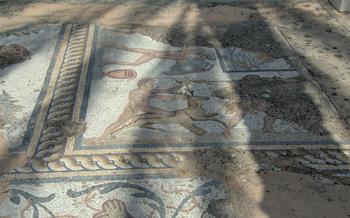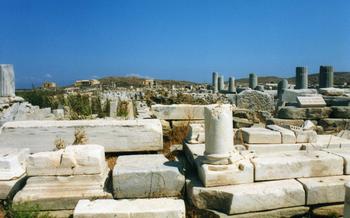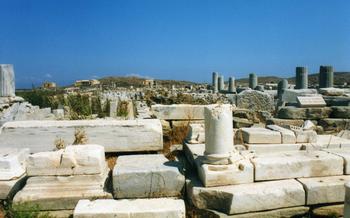
Asclepeion of Paros
- The Asclepeion of Paros: A Sacred Site of Healing
- Location and Getting There
- Exploring the Asclepeion
- Healing Rituals and Practices
- The Sacred Way
- The Temple of Asclepius
- The Stoas
- The Baths
- Votive Offerings
- Inscriptions
- Festivals and Events
- Local Cuisine and Products
- Sustainable Tourism
- Insider Tip: Unveiling Hidden Gems
The Asclepeion of Paros: A Sacred Site of Healing
The Asclepeion of Paros, an ancient sanctuary dedicated to the Greek god of medicine, Asclepius, holds a significant place in the history of healing and medicine. Archaeological excavations have unearthed the remains of this sacred site, revealing its impressive structures and shedding light on the practices and rituals that took place within its walls. The Asclepeion served as a place of pilgrimage for those seeking healing, offering a unique blend of religious devotion and medical treatment. Visitors came from far and wide to seek divine intervention and the expertise of the Asclepeion's priests and healers. The site's enduring legacy as a center of healing makes it a must-visit destination for anyone interested in the history of medicine and the cultural heritage of Greece.
Location and Getting There
The Asclepeion of Paros is conveniently situated just a short distance from the picturesque town of Parikia, the island's capital. This proximity makes it easily accessible for visitors who wish to delve into the site's rich history and explore its sacred grounds. To reach the Asclepeion, multiple transportation options are available, catering to the preferences and convenience of travelers.
Regular buses depart from Parikia and other parts of the island, providing a budget-friendly and reliable mode of transport. These buses drop off passengers near the Asclepeion's entrance, allowing for a seamless transition from the bustling town to the tranquil sanctuary.
For those seeking a more personalized experience, taxis are readily available in Parikia and can be hailed or arranged in advance. Taxis offer the flexibility to customize the journey, enabling visitors to set their own pace and make stops along the way to admire the island's scenic beauty.
For those who prefer the freedom to explore at their own leisure, rental cars are an excellent option. Car rental agencies in Parikia offer a wide range of vehicles to suit different needs and budgets. With a rental car, visitors can embark on a leisurely drive, enjoying the island's charming villages and stunning coastal views en route to the Asclepeion.
Exploring the Asclepeion
The Asclepeion of Paros is a fascinating complex with a wealth of structures and artifacts to discover. The main temple, dedicated to Asclepius, is the heart of the sanctuary. Constructed in the 4th century BC, the temple features an impressive marble statue of Asclepius, depicted as a bearded and benevolent figure. Votive offerings, such as marble plaques and statuettes, adorn the temple's walls, representing the gratitude of those who sought healing and experienced the god's divine intervention.
Beyond the temple, visitors can explore the stoas, or covered walkways, that surround the central courtyard. These stoas provided shelter from the sun and rain, serving as places for patients to rest and socialize while awaiting their treatments. The baths, located at the west end of the complex, played a crucial role in the healing process. Visitors could immerse themselves in the therapeutic waters, believed to possess healing properties, and experience relief from various ailments.
Other notable structures within the Asclepeion include the exedra, a semicircular seating area where patients could gather for discussions and consultations with the priests. The treasury, where offerings to the gods were stored, is another significant feature of the site. The Asclepeion of Paros offers a glimpse into the ancient world of medicine and religion, providing visitors with a unique and enriching experience.
Healing Rituals and Practices
The Asclepeion of Paros was not merely a temple but a vibrant center of healing, where ancient Greeks sought solace and restoration. Central to the healing process were rituals and practices steeped in tradition and belief.
Dreams played a pivotal role in the healing experience. Devotees would sleep in the sacred precinct, seeking divine guidance through dreams. Asclepius, or one of his divine entourage, was believed to appear in these dreams, offering diagnoses, prescribing remedies, or performing symbolic surgeries.
Incubation, a practice of sleeping in the temple for healing purposes, was another key element. Devotees would prepare for incubation by undergoing purification rituals, fasting, and making offerings to the gods. During their sleep, they hoped to receive divine visitations and healing interventions.
Herbal remedies also played a significant role. The Asclepeion had a dedicated garden where medicinal plants were cultivated. Priests and healers prepared potions, ointments, and herbal concoctions based on ancient recipes, using plants like dittany, mandrake, and saffron. These remedies were believed to have healing properties and were administered to patients seeking relief.
The healing rituals and practices at the Asclepeion were a testament to the holistic approach to health and well-being in ancient Greece. They combined faith, dreams, herbal medicine, and the power of suggestion to create a sacred space for healing and transformation.
The Sacred Way
The Sacred Way, a processional path paved with marble, holds immense significance at the Asclepeion. It served as the main artery connecting the town of Parikia to the sanctuary, allowing pilgrims and visitors to approach the healing center with reverence. Along this sacred route, ancient customs and rituals were observed, creating a profound atmosphere of devotion.
One of the most notable traditions associated with the Sacred Way was the carrying of offerings to the gods. Devotees would carefully transport valuable gifts, such as precious objects, animals, or even parts of their own bodies, as a gesture of gratitude for healing or a plea for divine intervention. These offerings were believed to possess the power to appease the gods and expedite the healing process.
Processions were another integral part of the Sacred Way's rituals. During these solemn ceremonies, participants would gather and march along the path, often carrying statues of Asclepius or other deities. The processions were accompanied by music, chanting, and prayers, creating a vibrant and spiritual spectacle. Through these rituals, the faithful sought to honor the gods, express their devotion, and invoke their blessings for healing and well-being.
The Temple of Asclepius
The centerpiece of the Asclepeion complex is the grand Temple of Asclepius, a testament to the god's healing powers. Constructed in the 4th century BC, the temple features an impressive Doric architectural style, characterized by its simple yet majestic lines. Its façade is adorned with stately columns, creating a sense of awe and reverence.
Inside the temple, visitors can immerse themselves in the sacred atmosphere where ancient rituals and ceremonies unfolded. The main chamber, or cella, houses a colossal statue of Asclepius, carved from gleaming white marble. This striking depiction of the god, with his commanding presence and benevolent gaze, evokes a sense of healing and hope.
The temple served as a place of worship and supplication for those seeking Asclepius' divine intervention. Devotees would offer sacrifices and prayers, seeking relief from ailments and seeking blessings for good health. The temple's sacred space was believed to be imbued with healing energy, attracting pilgrims from far and wide.
The Stoas
The stoas, or covered walkways, surrounding the central courtyard of the Asclepeion played a vital role in the sanctuary's daily life. These long, colonnaded structures provided shelter from the sun and rain, creating a comfortable environment for patients and visitors. They also served as social spaces, where people could gather to discuss their experiences, share stories, and seek advice from fellow pilgrims.
The stoas were not merely waiting areas. They were also used for various therapeutic purposes. Doctors and priests would often conduct medical consultations and treatments within the stoas, taking advantage of the fresh air and natural light. Patients could rest and recuperate on benches or couches placed along the stoas, enjoying the soothing atmosphere of the sanctuary.
The stoas were also adorned with numerous votive offerings, expressing gratitude for healing or seeking divine favor. These offerings ranged from simple plaques and statuettes to elaborate marble sculptures, reflecting the deep faith and devotion of those who visited the Asclepeion.
Today, the stoas stand as impressive reminders of the Asclepeion's once-bustling activity. Visitors can wander through these ancient corridors, imagining the conversations, prayers, and rituals that took place here centuries ago. The stoas offer a glimpse into the human side of the Asclepeion, where people from all walks of life came together in search of healing and hope.
The Baths
Of particular significance at the Asclepeion of Paros are the well-preserved baths, which played a crucial role in the healing process. These baths were not merely for hygiene but held therapeutic and ritualistic importance. The complex featured separate facilities for men and women, ensuring privacy and comfort.
The baths comprised several interconnected rooms, each serving a specific purpose. The first room, known as the apodyterium, functioned as a changing room. Here, visitors would undress and leave their belongings before entering the bath area. The adjacent room, the frigidarium, contained a cold water pool. Immersion in cold water was believed to close the pores and stimulate circulation, enhancing the healing effects of the baths.
The central room, the caldarium, housed a hot water pool. This was the most important part of the bathing ritual. The warm water, sometimes infused with therapeutic herbs, helped relax muscles, alleviate pain, and promote overall well-being. The caldarium also featured a laconicum, a dry heat room similar to a sauna, which induced sweating and further detoxification.
After experiencing the hot and cold baths, visitors would proceed to the tepidarium, a warm room that served as a transition space. This gradual change in temperature helped the body adjust and prevented sudden temperature shocks. The bathing ritual concluded in the unctorium, where visitors would anoint themselves with fragrant oils and ointments to moisturize and soothe their skin.
The baths at the Asclepeion of Paros were not just about physical cleansing but also about spiritual purification and healing. The combination of water therapy, heat therapy, and aromatherapy created a holistic experience that addressed both the body and the soul, promoting overall well-being and contributing to the reputation of the Asclepeion as a renowned healing center in the ancient world.
Votive Offerings
The Asclepeion of Paros is replete with votive offerings, tangible expressions of gratitude and devotion left behind by those who sought healing or wished to thank the gods for their recovery. These offerings, numbering in the thousands, provide a glimpse into the lives and beliefs of the ancient Greeks who visited this sacred site.
Votive offerings at the Asclepeion took various forms, reflecting the diverse backgrounds and circumstances of the pilgrims. Marble plaques, inscribed with messages of gratitude or prayers for healing, were a common sight. These plaques often depicted body parts, such as eyes, ears, or limbs, representing the specific ailments for which individuals sought divine intervention.
Statuettes of Asclepius and other deities were also popular offerings. These figurines, often made of bronze or terracotta, were believed to represent the gods themselves, acting as intermediaries between the mortal realm and the divine.
Another type of votive offering found at the Asclepeion was anatomical body parts, such as arms, legs, or internal organs. These offerings, crafted from marble or terracotta, symbolized the healing of specific body parts or the restoration of overall health.
The sheer number and variety of votive offerings at the Asclepeion underscore the profound faith and devotion that ancient Greeks placed in the healing powers of Asclepius. These offerings serve as a testament to the enduring legacy of this sacred site and the belief in divine intervention in the pursuit of health and well-being.
Inscriptions
The Asclepeion of Paros is a treasure trove of inscriptions, offering valuable insights into the history, practices, and visitors of this ancient sanctuary. These inscriptions, etched in stone or metal, provide a glimpse into the lives and beliefs of those who sought healing and divine favor at the Asclepeion.
Among the most notable inscriptions are dedications to Asclepius and other deities, expressing gratitude for healing or seeking protection and guidance. These inscriptions often include the names of the individuals or families who made the offerings, as well as the specific ailments they were seeking relief from.
Another type of inscription found at the Asclepeion is records of healing miracles. These accounts describe the illnesses or injuries that patients suffered from, the treatments they received at the sanctuary, and the miraculous cures they experienced. These inscriptions serve as a testament to the power of faith and the healing abilities attributed to Asclepius.
In addition to dedications and healing records, the Asclepeion also contains inscriptions that provide information about the sanctuary's administration and personnel. These inscriptions list the names of priests, officials, and other individuals who were responsible for the upkeep and operation of the site.
The inscriptions at the Asclepeion are a fascinating and valuable source of information, shedding light on the religious beliefs, healing practices, and daily life of the ancient Greeks. They offer a glimpse into the world of those who sought solace and healing at this sacred site, and they continue to captivate and inspire visitors to this day.
Festivals and Events
Paros, with its rich history and cultural heritage, offers a range of festivals and events that celebrate the island's unique traditions and showcase the legacy of the Asclepeion. One notable event is the Asclepieia Festival, held annually in July or August. This festival pays homage to the ancient healing sanctuary and features a variety of cultural performances, exhibitions, and workshops related to health, wellness, and ancient healing practices.
Another popular event is the Paros Food Festival, which takes place in September and celebrates the island's culinary delights. Visitors can savor traditional Greek dishes, sample local products, and learn about the island's gastronomic heritage. The festival often features cooking demonstrations, tastings, and workshops led by local chefs and food experts.
In addition to these larger-scale festivals, Paros hosts various smaller-scale events and workshops throughout the year. These events provide opportunities for visitors to learn about the island's history, culture, and natural environment. From traditional dance and music performances to guided walks and nature excursions, there's always something to discover and experience in Paros.
Local Cuisine and Products
When visiting the Asclepeion of Paros, immerse yourself in the flavors of traditional Greek cuisine. The island offers a delightful array of culinary treasures that will tantalize your taste buds. Sample the local catch of the day, freshly grilled and seasoned with aromatic herbs. Indulge in mouthwatering souvlaki, succulent skewers of marinated meats grilled to perfection. Don't miss the opportunity to try pastitsio, a comforting dish featuring layers of pasta, ground beef, and a creamy béchamel sauce.
For a sweet treat, savor the delectable loukoumades, golden-brown doughnuts drizzled with honey syrup and sprinkled with cinnamon. Refresh yourself with a glass of ouzo, a traditional anise-flavored spirit, or sip on a cool glass of local wine, relishing the flavors of the sun-kissed grapes.
As you explore the island, discover unique local products that showcase the essence of Paros. Visit traditional bakeries to find freshly baked bread, aromatic pastries, and handmade sweets. Browse local markets for an array of colorful fruits, vegetables, and herbs, bursting with freshness and flavor. Support local artisans by purchasing handmade crafts, pottery, and woven textiles, each piece a testament to the island's rich cultural heritage.
Sustainable Tourism
As you explore the Asclepeion and the island of Paros, consider practicing responsible tourism to minimize your environmental impact and preserve the site's cultural heritage. Here are some tips:
-
Respect the Site: Avoid touching or climbing on ancient structures, as this can cause damage. Stay on designated paths and trails to prevent erosion and protect the site's integrity.
-
Dispose of Waste Properly: Use designated waste bins and recycling points to dispose of your trash and recyclables. Help keep the site and its surroundings clean and free of litter.
-
Support Local Businesses: Choose to dine at traditional Greek restaurants and purchase souvenirs from local shops to support the local economy and preserve the island's cultural identity.
-
Be Mindful of Noise Levels: Keep your voice down and avoid making excessive noise, especially in areas where others may be seeking a peaceful and contemplative experience.
-
Educate Yourself: Learn about the history, culture, and significance of the Asclepeion and Paros before your visit. This will enhance your appreciation for the site and help you understand its importance.
Insider Tip: Unveiling Hidden Gems
As you explore the Asclepeion, keep an eye out for hidden gems that offer breathtaking views and unique experiences. Venture beyond the main complex and discover a secluded path leading to a panoramic viewpoint overlooking the Aegean Sea. The sunset from this spot is simply magical, painting the sky in hues of orange, pink, and purple. For a touch of adventure, follow the ancient trails that wind through the surrounding hills. These paths will lead you to hidden coves with crystal-clear waters, ideal for a refreshing swim or a peaceful moment of contemplation. Remember to bring your swimsuit and a sense of curiosity as you embark on this journey of discovery.
